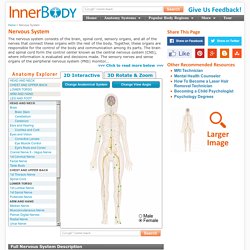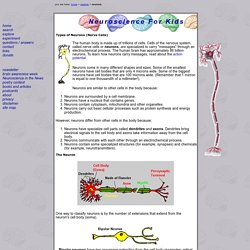

DownloadFile.cgi?file=14241-6-20265-opticalillusions01_1.pps&filename=opticalillusions01_1. Label Neuron Anatomy Printout. Explore the Brain. Advertisement.

EnchantedLearning.com is a user-supported site. As a bonus, site members have access to a banner-ad-free version of the site, with print-friendly pages.Click here to learn more. (Already a member? Click here.) THE FUNCTIONS OF THE BRAIN The human brain is a complex organ that allows us to think, move, feel, see, hear, taste, and smell. The brain produces electrical signals, which, together with chemical reactions, let the parts of the body communicate. The average human brain weighs about 3 pounds (1300-1400 g). At birth, the human brain weighs less than a pound (0.78-0.88 pounds or 350-400 g).
The brain consists of gray matter (40%) and white matter (60%) contained within the skull. The brain has three main parts: the cerebrum, the cerebellum, and the brain stem (medulla). NOURISHMENT OF THE BRAIN Although the brain is only 2% of the body's weight, it uses 20% of the oxygen supply and gets 20% of the blood flow. Cerebrospinal fluid (CSF) surrounds the brain. Seeing, Hearing and Smelling the World. Your Brain & Nervous System. Listen How do you remember the way to your friend's house?

Why do your eyes blink without you ever thinking about it? Where do dreams come from? Your brain is in charge of these things and a lot more. In fact, your brain is the boss of your body. Your brain has many different parts that work together. Cerebrum (say: suh-REE-brum) cerebellum (say: sair-uh-BELL-um) brain stem pituitary (say: puh-TOO-uh-ter-ee) gland hypothalamus (say: hy-po-THAL-uh-mus) The Biggest Part: the Cerebrum The biggest part of the brain is the cerebrum. <a href=" your favorite way to challenge your brain? When you're thinking hard, you're using your cerebrum. The cerebrum has two halves, with one on either side of the head. Listen The Cerebellum's Balancing Act Next up is the cerebellum. Because of your cerebellum, you can stand upright, keep your balance, and move around. Brain Stem Keeps You Breathing — and More Another brain part that's small but mighty is the brain stem. Listen Pituitary Gland Controls Growth Listen.
Nervous System: Interactive Views and Information. [Continued from above] . . . conditions inside and outside of the body and send this information to the CNS.

Efferent nerves in the PNS carry signals from the control center to the muscles, glands, and organs to regulate their functions. Nervous TissueThe majority of the nervous system is tissue made up of two classes of cells: neurons and neuroglia. Cells of the nervous system. Types of Neurons (Nerve Cells) The human body is made up of trillions of cells.

Cells of the nervous system, called nerve cells or neurons, are specialized to carry "messages" through an electrochemical process. The human brain has approximately 100 billion neurons. To learn how neurons carry messages, read about the action potential. Neurons come in many different shapes and sizes. Neurons are similar to other cells in the body because: Neurons are surrounded by a cell membrane.Neurons have a nucleus that contains genes.Neurons contain cytoplasm, mitochondria and other organelles.Neurons carry out basic cellular processes such as protein synthesis and energy production. However, neurons differ from other cells in the body because: Neurons have specialize cell parts called dendrites and axons. The Neuron One way to classify neurons is by the number of extensions that extend from the neuron's cell body (soma).
Pseudounipolar cells (example: dorsal root ganglion cells).